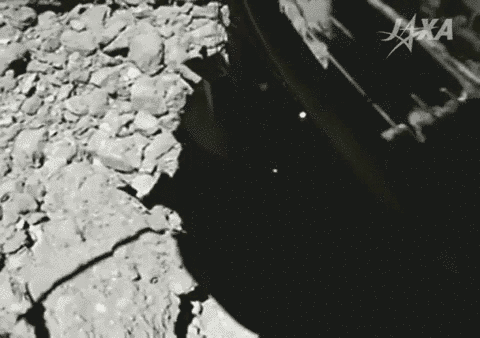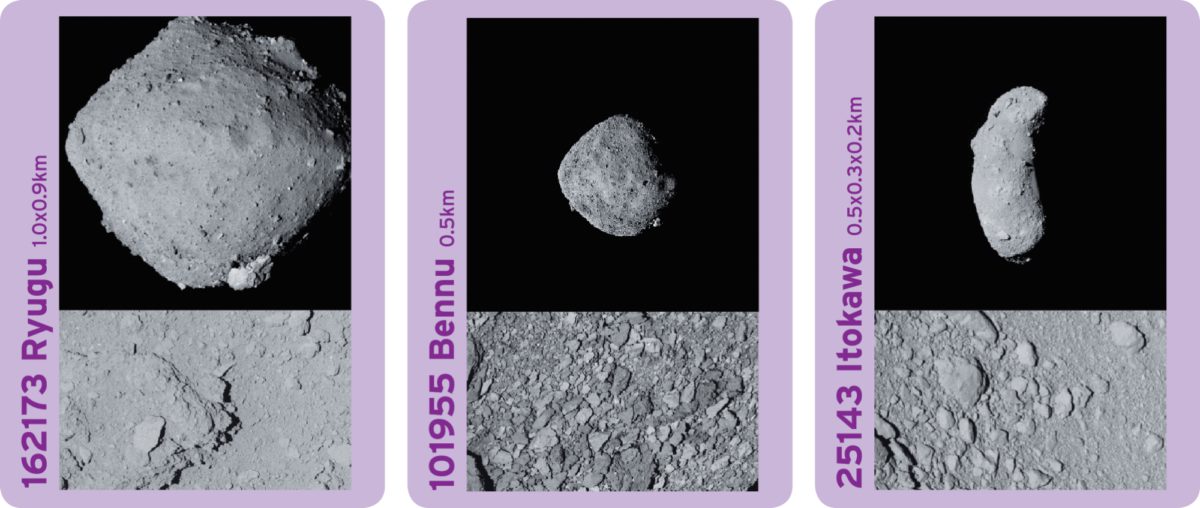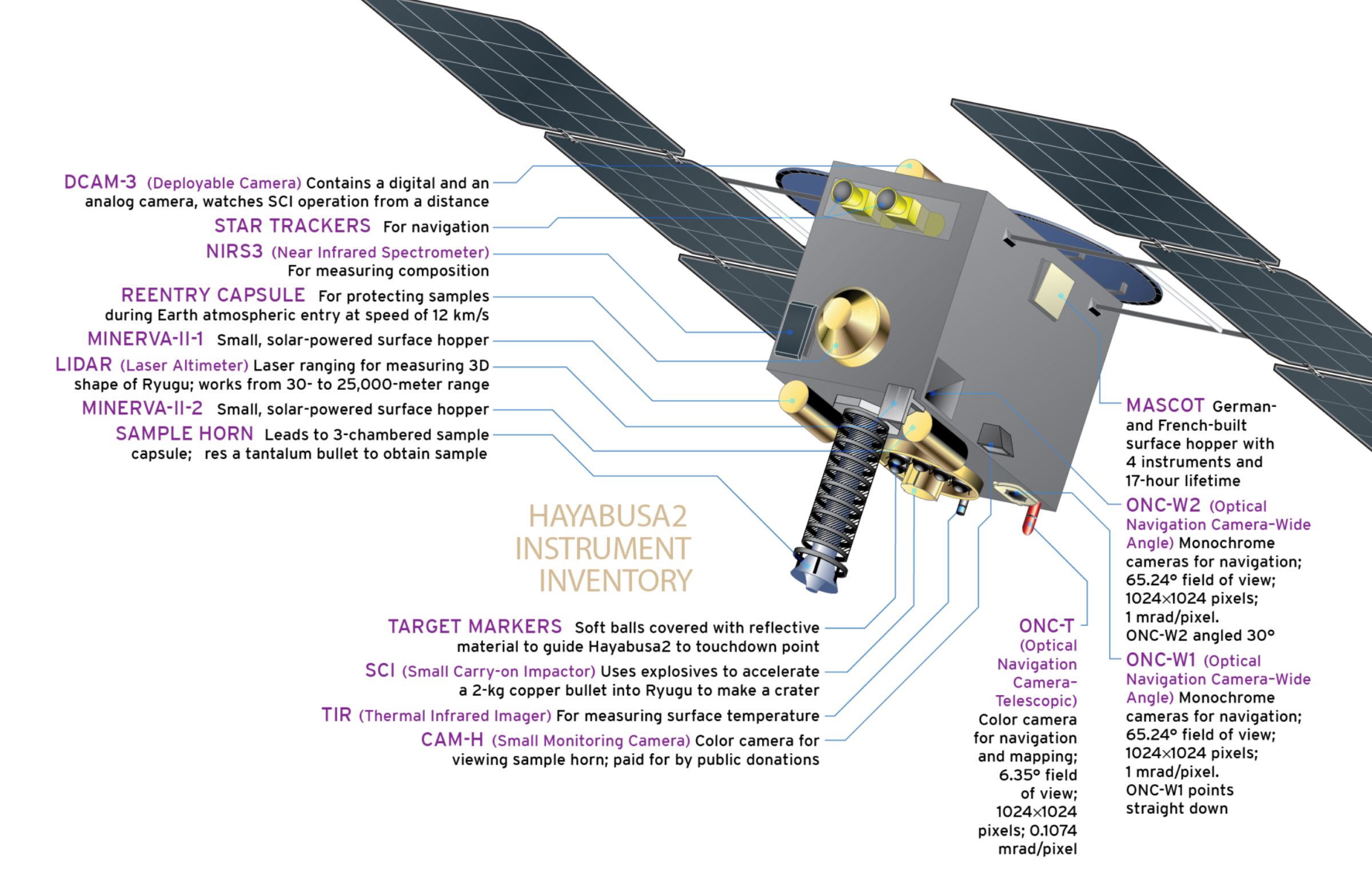Treasure Hunting With Hayabusa2
JAXA’s Fleet of Mini-Robots Lands on a World Full of Surprises

In the early hours of 22 February, light was just beginning to brighten the campus of JAXA’s Institute of Space and Astronautical Sciences (ISAS) in Kanagawa, Japan. It should have been a quiet time, but the Hayabusa2 control room was packed with people. We were about to land on an asteroid.
More than 340 million kilometers (210 million miles) away from us, our spacecraft hovered only meters above asteroid 162173 Ryugu, making sure of its targeting. Then, like its namesake peregrine falcon, Hayabusa2 descended and snatched a sample. When we received the images from the touchdown, we were surprised to see a dark stain over the sample site. Ryugu was already the darkest world ever visited; our brief touchdown had left it darker.
Mission to a NEO
Near-Earth objects (NEOs) like Ryugu are thought to have once been part of larger bodies that orbited in the asteroid belt between Mars and Jupiter. Collisions between asteroids and the push from solar radiation can move these bodies onto slightly different trajectories. These small changes can have orbital dynamics effects, such as a close approach to Mars that greatly changes the asteroid’s orbit so that it approaches the orbit of Earth as a NEO.
The Hayabusa2 mission is analyzing Ryugu’s composition through remote observation. These data, together with the examination of returned samples, should give us clues to this asteroid’s parentage. We can use this history to map the movement of water and organics through the solar system and to the terrestrial worlds. While returning a sample is a challenging and risky endeavor, the analyses that can be performed in a laboratory back here on the ground greatly outstrip anything that can be achieved in space.

The predecessor of Hayabusa2—the spacecraft Hayabusa—returned to Earth with a sample from an S-type asteroid, 25143 Itokawa, in 2010 (see The Planetary Report 30, no. 4). Ryugu is a C-type, or carbonaceous asteroid, a categorization for primitive asteroids that are expected to contain carbon-rich material. One theory for how Earth became habitable suggests that our young planet was pelted with meteorites from asteroids like Ryugu. These delivered water and simple organics that formed our seas and triggered the start of biology.
Testing this hypothesis drives the science behind Hayabusa2. If samples from asteroid Ryugu are found to contain hydrated (waterbearing) minerals or organic compounds that match those on Earth, then C-type asteroids may be a key component to forming a livable world.
Treasure Box
The Hayabusa2 asteroid explorer mission launched on 3 December 2014. Some 1,302 days later, the spacecraft arrived at its destination. On 27 June 2018, the spacecraft thrusters fired to maintain a constant position 20 kilometers (12 miles) from the asteroid on a line between Earth and Ryugu. This is our “home position,” where we perform the majority of our remote observations. Our instruments revealed a new world that surprised the whole team.
Ryugu is roughly 1 kilometer (0.6 miles) across and is shaped like a spinning top (or abacus bead), with a thick equatorial ridge. One of the most visually striking features is a 290-meter-diameter crater that straddles the equator, which we named Urashima. Urashima is the name of a character in Japanese legend who traveled to a dragon’s underwater palace, Ryugu castle, and brought back a treasure box.
The top shape was a surprise. Rapidly rotating bodies experience a centrifugal force that is the same outward push you feel on a merry-go-round. This can push material toward the equator to create the bulging shape of a spinning top. However, Ryugu rotates only once every 7.6 hours, which is too slow for reshaping by centrifugal force to occur. If rotation is the cause of the top shape, then the asteroid must have been spinning faster in the past.
Seen through the 7 different filters on the telescopic optical navigation camera, Ryugu appears homogenous in color, with a slight blue tinge to the equatorial ridge. The color homogeneity is consistent with the hypothesis that Ryugu formed from fragments of a larger asteroid that became well mixed as they coalesced. After it formed, the surface of Ryugu was weathered by radiation and light from the Sun, cosmic rays, and collisions with micrometeorites. This space weathering tends to make a surface darker and redder. When loose material slides down the slope of the steep equatorial ridge, the slides expose fresher material, offering a likely explanation for the ridge’s bluer hue.

The expected collisional history for NEOs meant that we anticipated that Ryugu would have a “rubble-pile” structure: rather than a coherent body, it’s made of rocks held loosely together by the asteroid’s gravity. We had expected to see a surface pitted with craters and boulders, interspersed with flatter regions and covered with a layer of finer-grained regolith. However, we were shocked to find that Ryugu appears to have almost no fine-grained regolith. A global look at Ryugu shows a homogeneous spread of boulders larger than 8 meters, while closer inspection reveals a high density of boulders about 1 meter in size. The largest boulder, 130 meters across and named Otohime Saxum, sits near the south pole.
Itokawa (the destination of Hayabusa) also had a surface covered in boulders. However, this asteroid had a flat plain with a width of about 50 meters covered with approximately centimeter- sized grains of regolith. We had expected a similar open space on Ryugu, and its absence made landing a serious challenge.
Roving an asteroid
Hayabusa2 has 4 different types of surface operations. The spacecraft carried 3 rovers, a European- built lander, and a Small Carry-on Impactor (SCI) for generating an artificial crater to expose subsurface material. The spacecraft itself also needed to touch the surface to gather material.
After almost 2 months of remote observations, the Japanese and international team members of the Hayabusa2 Joint Science Team gathered at ISAS to choose landing sites. Data from optical navigation cameras and a laser altimeter had been used to create a 3-dimensional model of the asteroid to guide the selection. Considerations such as surface temperature, local slope, and boulder density were major factors for the landing site selections, which also had to be safely separated in distance so as not to interfere with one another.
The day of intense discussion resulted in choosing sites on the asteroid’s northern side for the rovers, the southern side for the lander, and close to the equator for touchdown. The sites were also separated in longitude around the asteroid.
About a month later on 21 September, Hayabusa2 descended to a low altitude of about 55 meters over Ryugu’s surface and separated 2 of the rovers, MINERVA-II-1A and -1B, later named HIBOU and OWL. They were designed to test motion in a low-gravity environment. On Ryugu, there is not enough friction for wheels to roll.
The rovers therefore have an internal weight that rotates and rebounds to create a force that hops the rover across the surface. The rovers are solar powered and autonomous, hopping when their batteries are sufficiently charged. Cameras and thermal sensors send data back to Hayabusa2, providing a close-up look at the rugged landscape.
HIBOU and OWL transmitted data for 113 and 10 Ryugu days respectively and then went quiet. They may have moved into a shadowed region on the asteroid surface and may have been unable to recharge their batteries. It may be possible to regain contact with one or both as the Sun shifts on Ryugu’s surface later in the year.
On 3 October, Hayabusa2 descended once again to deploy the Mobile Asteroid Surface Scout (MASCOT) lander. The German (DLR) and French (CNES) space agencies provided this powerful, shoebox-sized laboratory. The lander was equipped with 4 instruments to image the surface, measure surface temperature and any magnetic field, and analyze the surface composition. Powered by a lithium battery, MASCOT was designed to last about 16 hours, or 2 asteroid days. It exceeded this expectation by operating for 17 hours, and the results are currently being analyzed by the European team.
The original plan was for Hayabusa2 to collect a sample at the end of October 2018. However, with the surface being more treacherous than expected, we decided to postpone that in order to further analyze a safe way to operate the touchdown. At the end of 2018, everyone on the team celebrated with a limited-edition “touchdown beer,” created by the Yatsugatake Brewery in Kiyosato. As Japan welcomed in the new year, we began preparations for descending.
Sample Grab
To confirm the technique for touchdown and to investigate the landscape in more detail, we performed 3 rehearsal descents in September and October 2018. During the third rehearsal, Hayabusa2 descended to an altitude of 12 meters and dropped a target marker, a highly reflective, baseball-sized object. A flashlight on the spacecraft can illuminate the marker while optical navigation cameras take photos. The reflective surface makes the marker easy to spot. The spacecraft can track the marker’s position and use that to navigate precisely during touchdown.

The high-resolution rehearsal images revealed exactly how challenging Ryugu’s terrain would be for sampling. Although the boulder density was lower in the chosen landing site than elsewhere on the asteroid, the flat area we finally selected for landing was only about 6 meters across. This was far smaller than the 100-meter flat region required by our original touchdown plan.
Touchdown was scheduled for about 8:00 a.m. Japan time on 22 February (23:00 UTC on 21 February), with the descent toward the surface beginning the morning before.
As the sampler horn touched the surface, Hayabusa2 fired a 5-gram tantalum bullet along its sampler horn and into the asteroid. This was designed to break up larger boulders and stir the surface material to allow a portion to rise up inside the sampler horn and into the sample container. Shortly after the spacecraft began to ascend, Hayabusa2 decelerated so that any material caught in the inverted teeth of the horn tip would be lifted into the container. At 11:20 a.m. (02:20 UTC), the first of the 3 chambers (“room A”) within the container closed. We were satisfied that we had collected our first sample.

Asteroid strike
In March, Hayabusa2 prepared to use its Small Carry-on Impactor (SCI) to generate an artificial crater at a site about 100 degrees east of the first touchdown point.
The SCI is a cylindrical container containing 9.5 kilograms (21 pounds) of explosive. When detonated, the explosion rapidly accelerates a 2-kilogram (4.4-pound) copper plate on the base of the SCI to a speed of about 2,000 meters per second. The plate strikes the asteroid to freshly expose subsurface material. This new crater will allow us to see material unaltered by space weathering, confirming if the blue tinge on the equatorial ridge is indeed from a less-weathered surface.

The SCI experiment worked as planned on 5 April. Before the SCI detonated, Hayabusa2 began an evacuation trajectory that took the spacecraft behind the asteroid and out to an altitude of about 3,500 meters at the moment of the explosion. We did not want to get hit by any escaping debris from the impact!


As this article goes to press, we are deciding whether to collect a second sample from a region close to the crater or from a second site on the asteroid. This second sample will likely be our last since by July, Ryugu will be nearing the perihelion of its orbit, and its surface will become too warm for touchdown operations.
Hayabusa2 will then continue to examine Ryugu remotely until the end of the year and return to Earth with the samples at the end of 2020. It is going to be a busy few years!
The Time is Now.
As a Planetary Defender, you’re part of our mission to decrease the risk of Earth being hit by an asteroid or comet.
Donate TodayThe Planetary Report • June Solstice
Help advance space science and exploration! Become a member of The Planetary Society and you'll receive the full PDF and print versions of The Planetary Report.


 Explore Worlds
Explore Worlds Find Life
Find Life Defend Earth
Defend Earth


